The proofs didn’t make it real.
The hard-bound book made it almost real.
And then a friend sent me this picture of his daughter, Josie.
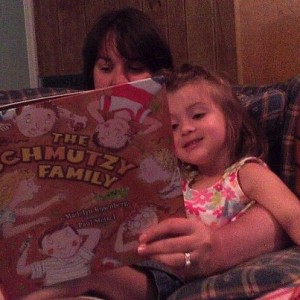
- Now it’s real!
The proofs didn’t make it real.
The hard-bound book made it almost real.
And then a friend sent me this picture of his daughter, Josie.

The following essay, about preparing for school visits, appeared in our SCBWI region’s quarterly newsletter, but I thought I’d share it here as well:
Looking for a Way to Prepare for Classroom Visits? Improvise!
By Madelyn Rosenberg
When my kids sang in front of 500 people at an elementary school concert, my first thought (after some justified kvelling) was: “I can’t do that.” It’s not just that I can’t sing. It’s that the idea of getting up in front of a large group of people in any capacity makes my spine turn to ice, my legs to green Jell-O. Small groups? Sure. I’ve taught college classes and stared into the bored faces of 24 sports management majors at once. But beyond 24? No way.
With my first books coming out in the fall, I thought about sticking a clause in my school visit synopsis: Author is chicken and will not speak in front of more than two dozen people, regardless of height. While that’s not completely off the table, I decided it might be better to adopt a different strategy; I decided to try to get over it. I started researching options: Toastmasters; Public Speaking for the Business Executive; Ten Ways to Conquer Your Fears of Public Speaking. Then, thanks to friends, including Sara Lewis Holmes, who has this subject streaming through OPERATION YES, her middle-grade novel, it hit me: Improv. Cue the light bulb and the Hallelujah chorus.
I found a class at The Comedy Spot, which is about a mile from my home in Arlington, Va. It had a big stage, a leaky roof, and a loud HVAC system. It was perfect. The class, which lasted nine weeks, focused on scene work, building characters, and thinking on your feet. Sound familiar? It was a new way of attacking what I do every day and as a bonus, I laughed so hard that on Monday nights, I went to sleep with aching cheeks.
We started by learning to speak gibberish and tossing an imaginary ball. Then we played the games that instructor Rachel Garmon plays with her professional improv crew for weekend shows. Example: Garmon gave us each a word, say “blender” or “paperclip.” Our job: Develop a character inspired by that word and give advice to the unemployed and lovelorn. Or maybe Garmon would give us a location, say “Antarctica.” We’d develop a set-up scene, then re-enact it as romantic comedy, tragedy or Kung Fu movie. Or we’d get a fairy tale, and perform it in 90 seconds, then 30, and then 7.
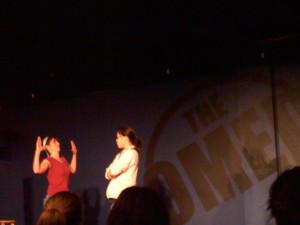
Snow White captured by my husband's old Android. I'm on the left as the Magic Mirror, telling the wicked queen she isn't all that.
We created machines that relied on sound and motion. We honed puns and groaned loudly. When we made mistakes, we bowed to wild applause. “I honestly believe there are no mistakes in improv except the mistake of not taking a risk,” says Garmon, who’s been doing improv for seven years. Her message? If you try something, own it. Be ridiculous. Be funny. Be fun. “For obvious reasons, it can help you get over stage fright,” Garmon says. “You have to be aware of what everyone else is doing while maintaining focus on the end product. You’re always analyzing and reacting. Improv also helps you find your natural voice. Through the characters you play, you find yourself.” (For the record, I found myself through a killer jackrabbit, Justin Bieber, and a hygiene-obsessed, post-menopausal woman named Gertrude.)
That Monday night class marked the most fun I’ve ever had with a group of strangers, although my classmates— bankruptcy lawyers and diplomats and baristas and chemistry teachers—aren’t strangers anymore. In many ways, I came to feel about them the way I feel about the people in my kid-lit critique group. I think that’s what happens when you make yourself vulnerable in front of other people—when you put yourself out there, and share laughter and blind trust.
For our final class, we put on a performance that was open to the public. The club didn’t hold 500 people, so I’m still not as brave as my kids. But I passed my 24-person threshold. And I survived. I’ll admit that I was nervous in the green room. I was still nervous when I stepped onto the stage. But I learned that it’s not nearly as nerve wracking when someone else shares the stage with you. So in the future, when I do school visits or book festivals, I’ll be sure to ask some volunteers to come up and keep me company.
My class taught me how to think fast and how to be a little ridiculous. I learned to take risks, to own them, and to laugh. That sounds like a recipe for a good school visit to me. It even sounds like a recipe for a good book—and for a good life.
Madelyn Rosenberg is the author of A SCHMUTZY SABBATH (Holiday House) and HAPPY BIRTHDAY, TREE: A TU B’SHEVAT STORY (Albert Whitman), which will both be released this fall.
In my move to try out as many different writing genres as possible, I wrote a short, one-act play about a picky Jewish man in search of a soul mate. I was thrilled when the Temple Players in Stratford, Conn., picked it up and decided to include it in their staged reading festival next weekend, June 21st and 24th. It’s one of six one-acts, all with Jewish themes, being included in the festival. I’m hoping they send pictures!
It’s been so incredibly cool to see how people interpret my writing in illustration. It’d be great to see how they did it out loud, through acting, too. But my cousin’s bat mitzvah is that weekend, back here, and I wouldn’t miss that for the world.
If you live in Stratford, Conn., perhaps you can check it out for me! The Temple Players’ listing for the play is here. A short article in the Stratford Star is here.

Doc in 2005, by Volker Neumann/Prawnpie from Flickr, used with permission
Back in 2000, I was working on a story about the great Doc Watson for The Roanoke Times. I knew a fair amount about him. I’d seen him play at least a dozen times, and I’d done my homework, like a reporter should, so I was familiar with his life story. I’d talked to people about him, too, which is how I learned he’d done all of the electrical rewiring for his house in Deep Gap, N.C. — an impressive feat for anyone, let alone a man who who’d lost his sight when he was less than a year old.
When I called him up, I felt like a school kid. I’d been reporting for a decade, but this was Doc.
He answered the phone on his back porch. “Give me a minute,” he said. “I’ve been working on the lawnmower, trying to get it ready for spring, and I have to clean up.”
“Oh,” I said, making conversation. “Getting ready to do some yard work?”
“Well, no, honey,” Doc said. “I’m blind.”
I wouldn’t have put anything past him. I still won’t. Heal up, Doc!
****
9 p.m. addendum
Really hoped he’d rally today.
Here’s a link to my story from 2000, just because. In it, Doc says (as he always has) that he wants to be remembered as a decent human being more than anything else. That, too, Doc.
And here’s some Deep River Blues to play us home:
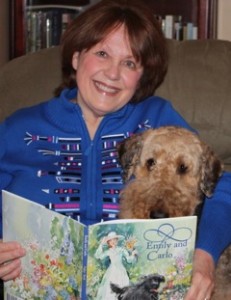
Friend and critique-group member Marty Rhodes Figley is taking a seat on the couch this week to talk about her new Charlesbridge picture book, Emily and Carlo, a lyrical exploration of the relationship between Emily Dickinson and her dog. It’s a good thing the couch is virtual, as my real couch comes with two medium-sized cats and Marty comes with one very large pooch.
Me: Let’s start by talking about your dog.
Marty: Scarlett is a seven-year-old Airedale terrier. This girl is very sociable and will edge her way to the center of any group so she can be admired and petted. She assumes that any gathering at our house is in her honor! She is a little spoiled. My husband insists if there is a fire and he and Scarlett both have broken legs and need help to escape, I’ll help Scarlett first.

Me: Have you always had dogs?
Marty: I grew up with poodles. As the oldest child, I was mostly in charge of feeding and grooming them—I think I learned then that I really liked having a dog to take care of. Of course, they also take care of you with their unconditional love! My husband and I have owned four fabulous dogs (all named after someone in literature). Two Samoyeds, Uncas (Last of the Mohicans) and Zelda (F. Scott’s naughty wife); Duncan, a Scottish terrier named after the murdered Scottish king in Macbeth; and our Airedale terrier, Scarlett (Gone With the Wind — another naughty girl).
Me: And Emily Dickinson had a Newfoundland — also a very large dog. Is that how you fell into this story?
Marty: It sounds like a cliché, but I really think I was meant to write this book. When I was twenty and wearing a white dress, I encountered my first Newfoundland, all 180-pounds of him. After about five seconds my dress was covered with dog slobber and long black dog hair. Years later, when I found out that Emily Dickinson’s constant companion for sixteen years was her Newfoundland dog, Carlo, my perception of the poet instantly changed. She was no ethereal woman dressed in immaculate white! Not with a Newfoundland close by! I knew I wanted to find out more about Emily’s relationship with her dog and share this view of an earthier, more human Emily Dickinson with children. Also, since I love dogs, it made the telling of their story all the more enjoyable!
They made a strange pair, one giant dog and one slight girl.
— MRF, from Emily and Carlo
Me: Talk a little about your history with Emily. You took a class at the Emily Dickinson Homestead?
Marty: About ten years ago, during an evening Shakespeare class at NOVA, my professor mentioned that three Seven Sister schools, Mount Holyoke, Smith and Wellesley colleges, offered excellent programs for nontraditional students. I was experiencing a lull in my publishing career, so I was tempted. When I told my husband about it, he graciously encouraged me to follow my dream, even though all those schools were in New England. Our kids were grown, we were between dogs, and he knew I had always regretted not finishing college. I enrolled at Mount Holyoke College—Emily Dickinson’s alma mater. I lived in a dorm on campus with traditional students for the next two years and graduated with a degree in American Studies at age 55. It was an empowering and very interesting experience.
During my second year, I couldn’t resist taking a course offered by the college at the Emily Dickinson Homestead in Amherst, Massachusetts. That’s where I first learned about Carlo, and made friends with fabulous Dickinson people who are affiliated with Mount Holyoke College and the Dickinson Homestead.
Me: The book is beautifully illustrated by Catherine Stock, who I understand splits her time between New York and France. Did you have much communication with her as you wrote?
Marty: Yes, the illustrations were reviewed several times for historical accuracy—the size of Emily’s desk, etc.
Catherine Stock is a consummate Emily Dickinson fan, and loves her poetry. I know she really enjoyed working on the project. She wanted to make the illustrations strong, honoring the strength of Emily. I think she succeeded in so many ways. Emily and Carlo is a truly gorgeous book—it was an honor to team up with Catherine — an exquisitely talented artist. I would love to do it again!
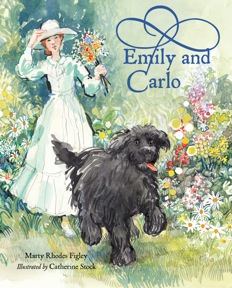
Me: Talk a little about the impact you feel the dog had on Emily’s writing.
Marty: Emily Dickinson was hard on her human friends. You can tell by reading her letters that she was lonely, and had a constant need for reassurance and attention. Her intensity was too much for some.
Emily’s literary mentor, Thomas Wentworth Higginson, described his first meeting with her. “I never was with anyone who drained my nerve power so much. Without touching her, she drew from me. I am glad not to live near her.”
Well, a dog is always there for you. Carlo provided stability in the life of this shy, poetic genius. He was her playmate, friend, protector, and guide to the outside world. Emily produced most of her greatest poetry during the years she spent with Carlo. After he died she wrote, “I explore but little since my mute confederate.”
Me: Do you feel like your animals have had an impact on your own writing?
Marty: Writing can be a lonely process. Having a loyal dog sleeping in the room (what else do dogs do more?) where you work is comforting. Also, if you want to whine about your publishing career, dogs are generally nonjudgmental. They love you no matter how many books you don’t sell.
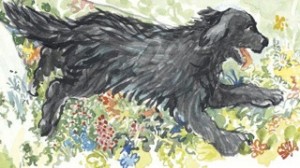
Me: One thing that people who aren’t writers don’t always realize is how long these things can take. You first sold Emily what year?
Marty: Yes, it can be a long time. I sold Emily and Carlo July 23, 2008! My editor thought the book might be moved up a list or two for an earlier publication. But, that didn’t happen. Also, we needed to wait until Catherine was available to illustrate the book. The wait was worth it!
Me: I’m wishing people could hear you talk, because they clearly can’t take Missouri out of the girl. Explain your own journey from Missouri to the D.C. area:
Marty: I grew up in Springfield, Missouri, “The Queen City of the Ozarks.” Actually, Springfield was a Country Music mecca when I was growing up, kind of like Nashville is today! My dad was a pioneer in the cable television industry and built small systems around the country beginning in the 1960’s. That took our family to Pennsylvania when I was in my late teens. After a couple of years, they moved back to Missouri, but I stayed and I eventually met my husband, Paul, while we were both students in Lancaster, PA. After a heavenly stint in Dallas (all that fabulous barbecue!) where my husband attended SMU Law School, we moved to the Washington, D. C. area, and have lived here for over 35 years.
Me: Let’s talk a little about food. I know for Clara Morgan and the Oregon Trail Journey, you were all about biscuits. I hear for Emily, it’s cookies?
Marty: I did make some Newf dog-shaped butter cookies for a book signing. I thought the kids would like them. I really wanted to ice them in black, but I kept visualizing that same black icing all over random book pages in the store. Maybe next time. Emily Dickinson was the baker in the Dickinson family. She even won a prize for her Indian Rye Bread. A favorite story told about her is how she lowered baskets of freshly baked gingerbread from her bedroom window to the waiting neighborhood kids below. That recipe is good (especially topped with whipped cream, warm from the oven), but it’s a wee bit on the pungent side for today’s youngsters’ taste buds.
Me: How are kids responding to the story? I feel like one thing that’s hard about history is you can’t really change how it turned out: whether you won or lost the war; whether the dog lives forever or … doesn’t.
Marty: I gave my first Emily and Carlo talk to kids in Pennsylvania a couple of weeks ago. The response was wonderful! Afterwards we talked about how all pets eventually leave us. I shared with them how I decided long ago that I’d rather love and eventually lose a dear pet, than not to have that experience at all.
Me: Is there anything you learned about Emily that you want to share that you couldn’t squeeze into your story?
Marty: She wrote about Carlo in forty of her letters and poems. Obviously, we couldn’t squeeze all her references to her dog into the book. Here’s one I especially like. It was written to her literary mentor, Thomas Wentworth Higginson, August 1862. Apparently Emily and Carlo had no patience with “blowhards!”
Of “shunning Men and Women” – they talk of Hallowed things, aloud and embarrass my Dog – He and I don’t object to them, if they’ll exist on their side. (L271)
Me: And finally: What’s your secret talent?
Marty: I make pretty good pies. My husband likes fruit pies and I guess I’ve been baking them forever. There are about a million ways to make a good crust. I just stick to the classic recipe from the old standard cookbook Joy of Cooking. Using a pastry cloth makes the rolling out part easier.

Me: What’s next for you? (Besides more pie?)
Marty: I’m working on a couple of “historical” projects. Scarlett keeps staring at me when I’m at the computer—I think she’s fed up with all this Newfoundland stuff and wants me to write a book about Airedale terriers. Now, that’s a thought!
Thanks so much to Marty (and you!) for stopping by. You can learn more about Marty and her other books from her web site and blog. Also, if you like to follow tangents: my friend Anamaria recently wrote about another new book, Minette’s Feast, which talks about Julia Child and her cat! Something in the air about famous people and the influence of their pets.